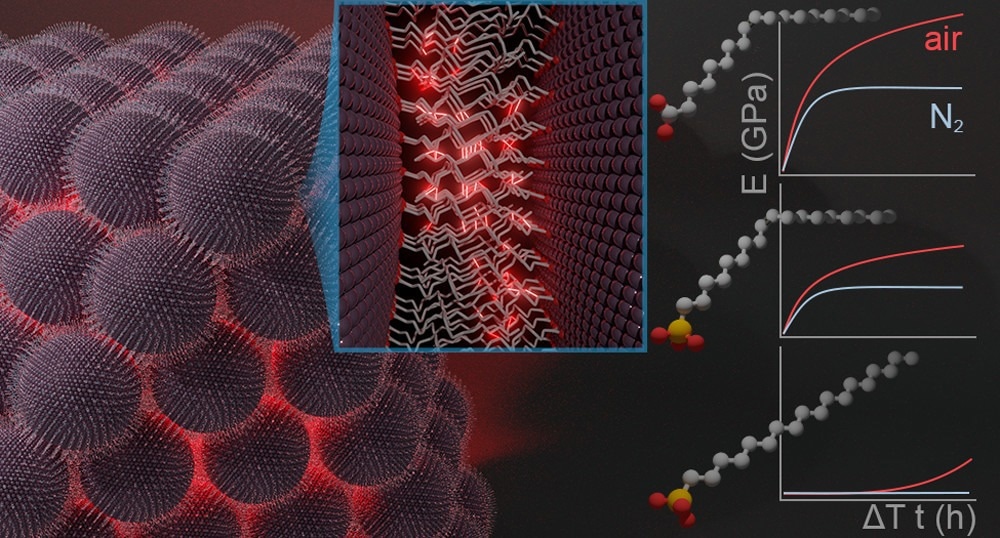The lack of knowledge of the self-assembly process and the poor structural stability of the resultant super crystal structures continue to restrict the use of nanocrystals in manufactured materials and devices.

Study: Strengthening Engineered Nanocrystal Three-Dimensional Superlattices via Ligand Conformation and Reactivity. Image Credit: Plunkett, A., Kampferbeck, M., Bor, B., Sazama, U., Krekeler, T., & Bekaert, L. (2022).
In a paper published in the journal ACS Nano, the effect of ligands on superlattice development and crosslinking by the annealing process was investigated. It was shown how the discovered mechanical knowledge might be exploited to modify the mechanical and nanostructural characteristics of the resulting nanoparticles.
Mesostructure Collective Phenomena
The regular organization of nano building blocks into unique structures, evocative of atoms in a crystal lattice, enables the mesostructure collection phenomenon to emerge while preserving the fundamental size-dependent features of nanocrystals (NC). The collective phenomenon may be considerably adjusted and improved by modifying the building-block materials, size, form, or assembly circumstances.
The possibilities are limitless, with anticipated applications spanning from mechanics and ophthalmology to electronics, to mention a few. Nevertheless, the deficiency of structural stability of these nanoarchitecture components, particularly as the size of the material is resampled, still hinders their growth into materials or further application into device applications.
Nature has suggested a possible solution to this problem. By hierarchically organizing nano building blocks with narrow, delicate interphases, nature has produced solid, durable, and durable materials such as bones, teeth, and nacre.
When nanocrystals are surface-functionalized with organic ligands and then organized into periodic structures, constrained interface organic ligands may be crosslinked to improve the resilience of super crystalline (SC) components.
Surface Ligands and their Advantages
It has been demonstrated that heating self-assembled organo-functionalized nanocrystals at mild temperatures increase a material's strength, rigidity, and flexibility while preserving a high level of tensile properties and performance.
Surface ligands, in particular, are beneficial for better material cohesiveness and fine-tuned superlattice creation and the final material's functioning and uses.
The interparticle spacing between nearby nanocrystals is one crucial characteristic that may be controlled by the ligands, where tiny changes can drastically impact the super crystalline aggregation characteristics and affect their photonic, conducting, or magnetic behavior.
Importance of Ligands
The influence of various ligands was explored on evaporating self-assembly using monodisperse magnetite nanocrystal centers with varying surface modifications. It was also illustrated how important it is to know the responsiveness of every NC@ligand combination when using them as crosslinking substrates.
Three surface ligands were investigated and chosen based on two factors: their aliphatic sequence and attachment group to the surface of the nanocrystals. After investigating the impact of each ligand component on the nanoarchitecture, a thermally induced reinforcing method was used through ligand crosslinking.
The ligands' behavior following rising temperatures is a vital step in not only enhancing material reliability through crosslinking and avoiding feature loss due to full organic dissolution. However, the precise process of this phase and its impacts on the ligand casing is still unknown.
The crosslinking process is dependent not only on the responsiveness of the particular ligands but also on their attachment to the nanocrystal center, which performs a catalytic function.
Understanding the function of ligands in superlattice generation and activation provides authority to intelligently adjust the physical properties of the resulting three-dimensional (3D) super crystalline components, which is a key step towards connecting the molecular and macroscopic length scales in super crystalline materials.
Highlights of the Study
Assessing the current mechanisms during nanocrystal self-assembly and super crystalline material responsiveness was critical not only for tailoring the characteristics of the final materials but also for identifying new appropriate material frameworks for designing novel, useful nanocomposite materials.
The influence of diverse surface ligands on supercrystalline formation and subsequent enhancement by thermal crosslinking was explored in hybrid conjunction nanocrystals frameworks. The usage of ligands with the same amount of C atoms and grafting concentration resulted in functionalized Fe3O4 spherical NCs with identical FCC concrete structures.
The inclusion of an aromatic unsaturation did not affect the super crystalline phases. All of the resultant inter particulate lengths were less than the length of two (extended) ligand molecules, indicating that the interacting ligands were interdigitated or twisted.
Main Outcomes of the Research
Here, the hardening was accomplished using a crosslinking-based rapid oxidative polymerization catalyzed by the nanocrystal’s base material. The attachment group of the ligands to the nanocrystal interface had a considerable effect on the central catalytic properties and, consequently, the degree of crosslinking.
Furthermore, the crosslinking phase could be modified by identifying the oxidative mechanisms that regulated the crosslinking process. Adopting an oxygen-rich environment required much lower temperatures for the crosslinking process, potentially preventing temperature-induced nanostructural harm to the nanoarchitectures.
The mechanical characteristics and interparticle spacing of the generated supercrystalline nanostructures were tailored separately by altering the heating rate and environment.
This finally allowed for tuning the mesostructured collective characteristics of functional nanomaterials while preserving strong mechanical responsiveness, both of which are critical stages towards their implementation.
Reference
Plunkett, A., Kampferbeck, M., Bor, B., Sazama, U., Krekeler, T., & Bekaert, L. (2022). Strengthening Engineered Nanocrystal ThreeDimensional Superlattices via Ligand Conformation and Reactivity. ACS Nano. Available at: https://doi.org/10.1021/acsnano.2c01332
Disclaimer: The views expressed here are those of the author expressed in their private capacity and do not necessarily represent the views of AZoM.com Limited T/A AZoNetwork the owner and operator of this website. This disclaimer forms part of the Terms and conditions of use of this website.